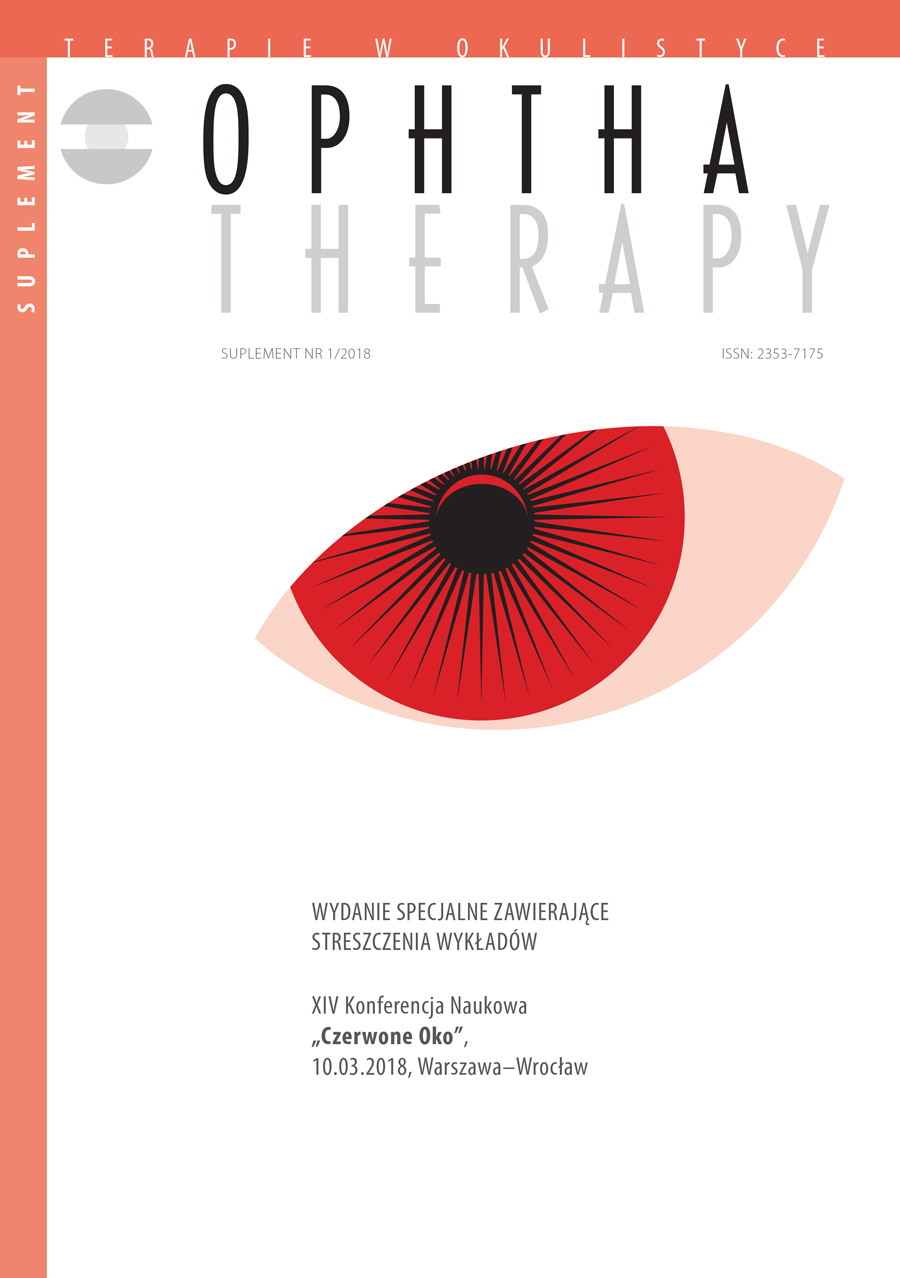Ocular demodicosis – a contemporary clinical condition
Main Article Content
Abstract
Demodex ocular infestation becomes more and more common ophthalmological problem, with incidence increasing with age. One of the reasons of growing morbidity is probably the general aging problem of the society. There are 2 different Demodex species, being pathogenetic factors in human: Demodex brevis (Meibomian gland infections) and Demodex folliculorum (ciliary glands infestations). The diagnosis of the disease should always be confirmed by thorough microbiological microscopic examination of eyelashes, specifying the count of eggs, larves and grown mites. There is no existing unequivocal and standardized therapeutic algorithm in ocular demodicosis, accepted widely be scientific bodies worlwide. In the year 2017 group of experts of Polish Ophthalmological Society adopted the general guidelines in Demodex infestation therapy, dealing with particular medications as well as with different ways of obeying the eyelids hygiene rules. The demodicosis therapy must be persistent, althougt being not always completely satisfactory. Its’ aim is to relieve patient from recurrent ocular symptoms, rather than to fully eradicate mites, existing sometimes only as the harmless commensals in patients.
Downloads
Article Details

This work is licensed under a Creative Commons Attribution-NonCommercial-NoDerivatives 4.0 International License.
Copyright: © Medical Education sp. z o.o. License allowing third parties to copy and redistribute the material in any medium or format and to remix, transform, and build upon the material, provided the original work is properly cited and states its license.
Address reprint requests to: Medical Education, Marcin Kuźma (marcin.kuzma@mededu.pl)
References
2. Post CE, Juhlin E. Demodex folliculorum and blepharitis. Arch Dermatol. 1963; 88: 298-302.
3. Nicholls SG, Oakley CL, Tan A et al. Demodex species in human ocular disease: new clinicopathological aspects. Int Ophthalmol. 2017; 37(1): 303-12.
4. Lacey N, Kavanagh K, Tseng SCG. Under the lash: Demodex mites in human diseases. Biochem (Lond). 2009; 31(4): 2-6.
5. Sędzikowska A, Osęka M, Skopiński P. Ocular Demodicosis as a Potential Cause of Ocular Surface Inflammation. Cornea. 2017; 36(suppl 1): S9-14. https://doi.org/10.1097/ICO.0000000000001361.
6. Thoemmes MS, Fergus DJ, Urban J et al. Ubiquity and diversity of human-associated Demodex mites. PLoS One. 2014; 9(8): e106265. https://doi.org/10.1371/journal.pone.0106265.
7. Garbacewicz A, Udziela M, Grytner-Ziecina B et al. Demodex infections in general Polish population, in patients suffering from blepharitis, and among people who work with microscopes. Klin Oczna. 2010; 112(10-12): 307-10.
8. Herron MD, O’Reilly MA, Vanderhooft SL et al. Refractory Demodex folliculitis in five children with acute lymphoblastic leukemia. Pediatr Dermatol. 2005; 22(5): 407-11.
9. Ivy SP, Mackall CL, Gore L et al. Demodicidosis in childhood acute lymphoblastic leukemia: an opportunistic infection occurring with immunosuppression. J Pediatr. 1995; 127(5): 751-4.
10. Cogen AL, Nizet V, Gallo RL. Skin microbiota: a source of disease or defence? Br J Dermatol. 2008; 158: 442-55.
11. Liang L, Ding X, Tseng SC. High prevalence of demodex brevis infestation in chalazia. Am J Ophthalmol. 2014; 157(2): 342-8.e1. https://doi.org/10.1016/j.ajo.2013.09.031.
12. Tarkowski W, Owczyńska M, Błaszczyk-Tyszka A et al. Demodex mites as potential etiological factor in chalazion – a study in Poland. Acta Parasitol. 2015; 60(4): 777-83. https://doi.org/10.1515/ap-2015-0110.
13. Zhang XB, Ding YH, He W. The association between demodex infestation and ocular surface manifestations in meibomian gland dysfunction. Int J Ophthalmol. 2018; 11(4): 589-92. https://doi.org/10.18240/ijo.2018.04.08.
14. Tarkowski W, Moneta-Wielgoś J, Młocicki D. Do Demodex mites play a role in pterygium development? Med Hypotheses. 2017; 98: 6-10. https://doi.org/10.1016/j.mehy.2016.09.003.
15. Lacey N, Russell-Hallinan A, Zouboulis CC et al. Demodex mites modulate sebocyte immune reaction: Possible role in the pathogenesis of rosacea. Br J Dermatol. 2018. https://doi.org/10.1111/bjd.16540.
16. Tarkowski W, Moneta-Wielgoś J, Młocicki D. Demodex sp. as a Potential Cause of the Abandonment of Soft Contact Lenses by Their Existing Users. Biomed Res Int. 2015; 2015: 259109. https://doi.org/10.1155/2015/259109
17. Czepita D, Kuźna-Grygiel W, Czepita M et al. Demodex folliculorum and Demodex brevis as a cause of chronic marginal blepharitis. Ann Acad Med Stetin. 2007; 53(1): 63-7.
18. Szkaradkiewicz A, Chudzicka-Strugała I, Karpiński TM et al. Bacillus oleronius and Demodex mite infestation in patients with chronic blepharitis. Clin Microbiol Infect. 2012; 18(10): 1020-5.
19. Polskie Towarzystwo Okulistyczne. Postępowanie w demodekozie ocznej. https://pto.com.pl/wytyczne (Access: 15.03.2017).
20. Salem DA, El-Shazly A, Nabih N et al. Evaluation of the efficacy of oral ivermectin in comparison with ivermectin-metronidazole combined therapy in the treatment of ocular and skin lesions of Demodex folliculorum. Int J Infect Dis. 2013; 17(5): 343-7.
21. Sędzikowska A. Demodekoza – patofizjologia, leczenie oraz ocena skuteczności terapii z zastosowaniem maści z metronidazolem oraz maści z tlenkiem rtęci. OphthaTherapy. 2014; 2(2): 108-13.
22. Krajewska M, Wasyluk J, Sędzikowska A et al. Ocena skuteczności i bezpieczeństwa preparatów Demoxoft Lipożel i Demoxoft stosowanych u chorych na nużeńcowe zapalenie brzegów powiek – wyniki wstępne. Okulistyka. 2013; wyd. spec. październik: 9-11.
23. Tighe S, Gao YY, Tseng SC. Terpinen-4-ol is the Most Active Ingredient of Tea Tree Oil to Kill Demodex Mites. Transl Vis Sci Technol. 2013; 2(7): 2.
24. Lam NSK, Long XX, Griffin RC et al. Can the tea tree oil (Australian native plant: Melaleuca alternifolia Cheel) be an alternative treatment for human demodicosis on skin? Parasitology. 2018: 1-11. https://doi.org/10.1017/S0031182018000495.
25. Gao YY, Di Pascuale MA, Elizondo A et al. Clinical treatment of ocular demodecosis by lid scrub with tea tree oil. Cornea. 2007; 26(2): 136-43.

